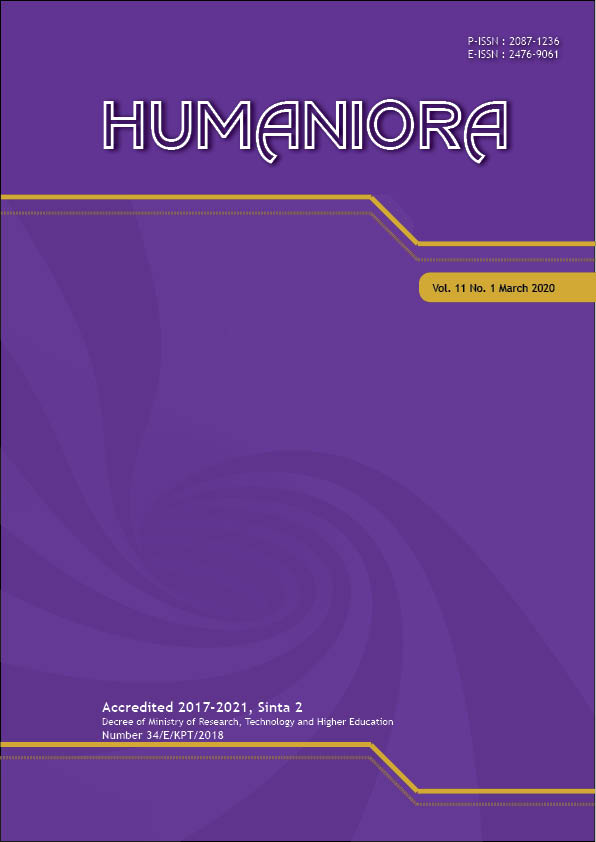Peraq Api Tradition in Lombok: A Bourdieu Perspective Review
DOI:
https://doi.org/10.21512/humaniora.v11i1.6205Keywords:
peraq api, Lombok tradition, Bourdieu review, TawhidAbstract
The research aimed to dismantle the meaning of peraq api in its social practices involving habitus and the field in Sasak cosmology. Pierre Bourdieu’s social practice theory was used as an analysis to uncover the meanings built in the tradition of the peraq api. The meaning of peraq api in its social practice was discussed using qualitative methods, interpretative descriptive data analysis techniques, and using a hermeneutic approach. The results of indicate that the tradition of peraq api is a manifestation of life that represents the creation of beings. This happens because the attitude and perspective of Sasak society about nature originated from the monotheism’s cosmology. This perspective gives rise to behavior to maintain the cosmological balance. Tawhid is a general view of reality, truth, the world, space and time, and human history, which is represented through the tradition of the peraq api.
Â
References
Adib, M. (2012). Agen dan struktur dalam pandangan Piere Bourdieu. Jurnal BioKultur, 1(2), 91–110.
Ansori, Z. (2018). Tradisi ‘Peraq Api’ dalam dinamika perubahan sosial pada masyarakat Kawo. Jurnal Schemata: Pascasarjana UIN Mataram, 7(1), 61–75. https://doi.org/10.20414/schemata.v7i1.313.
Bagus, L. (1996). Kamus filsafat (Ed. 1). Jakarta: Gramedia Pustaka Utama.
Bakhtiar, L. (2008). Mengenal ajaran kaum Sufi. Jakarta: Atmaja.
Bakker, A. (1995). Kosmologi dan ekologi: Filsafat tentang kosmos sebagai rumahtangga manusia. Cibubur: Kanisiusmedia.
Barker, C., Putranto, H., & Arya, N. (2014). Kamus kajian budaya. Yohyakarta: Kanisius.
Eller, J. D. (2007). Introducing anthropology of religion: Culture to the ultimate. Abingdon: Routledge.
Fadjri, M. (2015). Mentalitas dan ideologi dalam tradisi historiografi Sasak-Lombok pada abad XIX-XX. (Dissertation). Yogyakarta: Universitas Gadjah Mada.
Fathurrachman, L. (2007). Menuju masa depan peradaban: Refleksi budaya di NTB (1st Ed.). Jakarta: Genta Press.
Fathurrachman, L., & Irawan, L. A. (2016). Membaca arsitektur Sasak. Mataram: Genius.
Fathurrachman, L. (2017). Kosmologi Sasak: Risalah inen paer. Mataram: Genius.
Fitriani. (2016). Pandangan filsafat Pendidikan Islam terhadap manusia, masyarakat, dan lingkungan. Jurnal Intelektualita, 4(1), 47–65.
Harker, R., Mahar, C., Wilkes, C., & Rahmana, S. (Eds.). (2009). (Habitus x Modal) + Ranah = Praktik: Pengantar paling komprehensif kepada pemikiran Pierre Bourdieu. Translated by P. Maizier (2nd Ed.). Yogyakarta: Jalasutra.
Herawati, A. (2015). Keindahan sebagai elemen spiritual perspektif Islam tradisional. Jurnal Kawistara, 5(2), 155-170. https://doi.org/10.22146/kawistara.7588.
Hidayat, S. (2017). Teori sosial Pierre Bourdieu dan sumbangannya terhadap penelitian sastra (Pierre Bourdieu’s social theory and its contribution toward literary research). METASASTRA: Jurnal Penelitian Sastra, 3(1), 43-52. https://doi.org/10.26610/metasastra.2010.v3i1.43-52.
Iqbal, I. (2014). Kosmologi, sains, dan teknologi: Pergeseran paradigmatik dan implikasinya terhadap studi agama. Jurnal KALAM, 8(1), 27-42. https://doi.org/10.24042/klm.v8i1.166
Karnanta, K. Y. (2013). Paradigma teori arena produksi kultural sastra: Kajian terhadap pemikiran Pierre Bourdieu. Jurnal Poetika, 1(1), 3–15.
Krisdinanto, N. (2016). Pierre Bourdieu, Sang juru damai. KANAL: Jurnal Ilmu Komunikasi, 2(2), 189-206. https://doi.org/10.21070/kanal.v2i2.300.
Maryam, S. (2018). Eksistensi sufisme Sasak dalam novel ‘Sanggarguri’ dan perannya dalam kehidupan masyarakat di Lombok. Genta Bahtera Jurnal Ilmiah Kebahasaan Dan Kesastraan, 4(1), 33–48. http://dx.doi.org/10.26499/gb.v4i1.44.
Ningtyas, E. (2015). Pierre Bourdieu, language, and symbolic power. Jurnal Poetika, 3(2), 154-157. https://doi.org/10.22146/poetika.10437.
Pitana, T. S. (2014). Teori sosial kritis: Metode dan aplikasinya. Purwokerto: STAIN Press.
Prayitno, U. S. (2017). Revolusi mental dalam perspektif budaya Jawa: Analisis melalui pemikiran Pierre Bourdieu. Jurnal Aspirasi, 8(2), 223-234. doi: https://doi.org/10.22212/aspirasi.v8i2.1267.
Reay, D. (2004). ‘It’s all becoming a habitus’: Beyond the habitual use of habitus in educational research. British Journal of Sociology of Education, 25(4), 431–444. https://doi.org/10.1080/0142569042000236934.
Sattar, A. (2010). Filsafat Islam: Antara duplikasi dan kreasi. Ulumuna Jurnal Studi Keislaman, 17(1), 1–20.
Siregar, M. (2016). Teori “gado-gado†Pierre-Felix Bourdieu. Jurnal Studi Kultural, 1(2), 79–82.
Suhardi, S., Yasri, H., & Suhardi, M. (2010). Upacara daur hidup suku Sasak. Jakarta: Pustaka Widya.
Syakir, S. (2016). Seni perbatikan Semarang: Tinjauan analitik prespektif Bourdieu pada praksis arena produksi kultural. Jurnal Imajinasi, 10(2), 121–132. doi: https://doi.org/10.15294/imajinasi.v10i2.8806.
Wahyudin, D. (2018). Identitas orang Sasak: Studi epistemologis terhadap mekanisme produksi pengetahuan masyarakat suku Sasak. Jurnal Penelitian Keislaman, 14(1), 51–62.
Wati, K. S. (2015). Modal dalam praktik sosial arisan sosialita. Jurnal Idea Societa, 2(5), 1–27.
Zuhdi, M. H. (2014). Dialektika hukum Islam dengan tradisi lokal. IstinbÄth: Jurnal Hukum Islam, 13(2), 156–180.
Zurmailis, Z., & Faruk, F. (2018). Doksa, kekerasan simbolik dan habitus yang ditumpangi dalam konstruksi kebudayaan di Dewan Kesenian Jakarta. AdabiyyÄt: Jurnal Bahasa dan Sastra, 1(1), 44-72. https://doi.org/10.14421/ajbs.2017.011030.
Downloads
Published
How to Cite
Issue
Section
License
Authors who publish with this journal agree to the following terms:
a. Authors retain copyright and grant the journal right of first publication with the work simultaneously licensed under a Creative Commons Attribution License - Share Alike that allows others to share the work with an acknowledgment of the work's authorship and initial publication in this journal.
b. Authors are able to enter into separate, additional contractual arrangements for the non-exclusive distribution of the journal's published version of the work (e.g., post it to an institutional repository or publish it in a book), with an acknowledgment of its initial publication in this journal.
c. Authors are permitted and encouraged to post their work online (e.g., in institutional repositories or on their website) prior to and during the submission process, as it can lead to productive exchanges, as well as earlier and greater citation of published work.
USER RIGHTS
All articles published Open Access will be immediately and permanently free for everyone to read and download. We are continuously working with our author communities to select the best choice of license options, currently being defined for this journal as follows: Creative Commons Attribution-Share Alike (CC BY-SA)


















